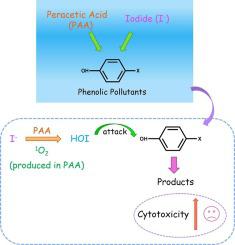Chemical Engineering Journal ( IF 13.3 ) Pub Date : 2023-10-16 , DOI: 10.1016/j.cej.2023.146725 Jiamin Mai , Ge Zeng , Linqian An , Maoju Jiang , Peng Su , Qixiao Lv , Xiangyang Hou , Xiujuan Kong , Jianbo Jia , Tao Yang , Jun Ma

|
Peracetic acid (PAA) has been used as a disinfectant/oxidant in wastewater treatment. However, considering that the presence of iodide (I−) would induce the iodinated products in wastewater, the effect of I− on the transformation of phenolic pollutants by PAA was investigated. Herein, the presence of I− enhanced the transformation of phenolic pollutants (bisphenol S (BPS), bisphenol A (BPA), and p-hydroxybenzoic acid (p-HBA)) by PAA. Furthermore, hypoiodous acid (HOI) was reactive species in the PAA/I− system based on radical quenching experiments and electron spin resonance. In this system, PAA, together with 1O2 that was produced in PAA oxidized I− into HOI. Increasing PAA and I− dose promoted the transformation of phenolic pollutants but the promoting effect was less significant at higher dosage. The increase in H2O2 dose retarded the transformation of phenolic pollutants because of HOI being quenched by H2O2. In a wide range of pH (pH 4.0–10.0), the transformation of BPS, BPA, and p-HBA was pH-dependent and most effective at pH 7.0. The presence of chloride and bromide accelerated the transformation of phenolic pollutants by PAA/I− due to the formation of HOCl and HOBr. Furthermore, HOI substitution was the primary reaction pathway in the transformation of BPS, BPA, and p-HBA by PAA/I−. Finally, the transformation products of phenolic pollutants during the PAA/I− posed higher cytotoxicity compared to the parent pollutants. Overall, our findings improved the understanding of the chemical behavior of PAA in the presence of I− and suggested that the generation of iodinated products raised concerns for water safety.
中文翻译:

在碘化物存在下,过乙酸转化酚类污染物期间,单线态氧还参与次碘酸的形成
过氧乙酸(PAA)已在废水处理中用作消毒剂/氧化剂。然而,考虑到碘化物( I− )的存在会导致废水中产生碘化产物,因此研究了I−对PAA转化酚类污染物的影响。其中,I -的存在增强了PAA 对酚类污染物(双酚 S ( BPS)、双酚 A (BPA) 和对羟基苯甲酸 ( p -HBA))的转化。此外,根据自由基猝灭实验和电子自旋共振,次碘酸(HOI)是PAA/I -系统中的活性物质。在该系统中,PAA与PAA中产生的1 O 2一起将I -氧化成HOI。增加PAA和I-剂量可促进酚类污染物的转化,但较高剂量时促进作用不太显着。H 2 O 2剂量的增加延缓了酚类污染物的转化,因为HOI被H 2 O 2猝灭。在较宽的 pH 范围内(pH 4.0–10.0),BPS、BPA 和p -HBA的转化具有 pH 依赖性,并且在 pH 7.0 时最有效。由于形成 HOCl 和 HOBr,氯化物和溴化物的存在加速了 PAA/ I对酚类污染物的转化。此外,HOI取代是PAA/I -转化BPS、BPA和p -HBA的主要反应途径。最后,与母体污染物相比, PAA/I期间酚类污染物的转化产物具有更高的细胞毒性。总体而言,我们的研究结果加深了对 I 存在下 PAA 化学行为的理解,并表明碘化产品的生成引起了人们对水安全的担忧。













































 京公网安备 11010802027423号
京公网安备 11010802027423号